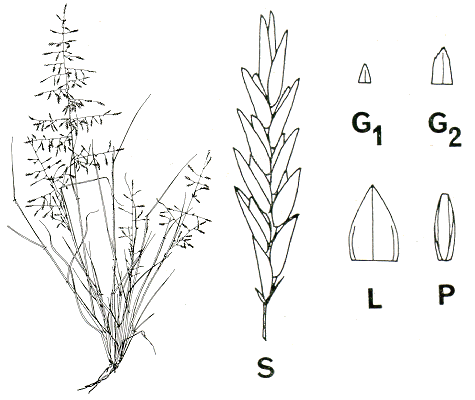Eragrostis tenuifolia* (A.Rich.) Steud. Syn.
Pl. Glum. 1: 268 (1854).
Classification. (GPWG 2001) : Subfamily
Chloridoideae. Cynodonteae.
Basionym and/or
Replacement Name: Poa tenuifolia
A. Rich., Tent. Fl. Abyss..
Type of Basionym or
Protologue Information: LT: G.H.W. Schimper 92, Jan 1841 [18 Sep
1837], Ethiopia:
in locis incultis Vallium prope Adoam (P; ILT: GOET-5814, K, L, WAG, US-1127147
(fragm.)). LT designated by S. Phillips, Fl. Ethiopia 7: 122 (1995).
ST: Quartin Dillon
s.n., Oct, Ethiopia:
crescit in montosis Chiré (P).
Key references
(books and floras): [1969] E.E.Henty, Manual Grasses New Guinea
(96), [2002] D.Sharp & B.K.Simon, AusGrass, Grasses of Australia,
[2008] S.W.L.Jacobs, R.D.B.Walley & D.J.B.Wheeler, Grasses of New South
Wales (257).
Illustrations:
[2008] S.W.L.Jacobs, R.D.B.Whalley & D.J.B.Wheeler, Grasses of New South
Wales, 4th edn (257).
Habit.
Perennial. Culms erect or geniculately ascending, 10–92 cm tall. Ligule a
fringe of hairs, 0.2–0.5 mm long. Leaf-blades straight, flat or involute, 4–30
cm long, 1–4 mm wide.
Inflorescence.
Inflorescence compound, a panicle. Panicle elliptic, 5–28 cm long.
Spikelets.
Spikelets pedicelled. Fertile spikelets many flowered, with at least 2 fertile
florets (4–16), comprising 4–16 fertile floret(s), with diminished florets at
the apex, linear, laterally compressed, 4–16 mm long.
Glumes. Glumes
similar. Lower glume lanceolate, without keels or keeled, 1-keeled, 1 -nerved.
Upper glume lanceolate, 0.8–1.7 mm long, without keels or keeled, 1-keeled, 1
-nerved.
Florets.
Fertile lemma 1.6–2.5 mm long, keeled, 3 -nerved. Lemma apex muticous. Anthers
3. Grain 1 mm long.
Continental
Distribution: Africa, Temperate Asia, Tropical Asia, Australasia, Pacific,
North America, and South America.
Australian
Distribution: Western Australia, Northern Territory, Queensland,
New South Wales, Tasmania.
Western
Australia: Gardner.
Northern Territory: Central
Australia North. Queensland:
Burke, Burnett, Cook, Leichhardt, Moreton, North Kennedy, Port Curtis, South
Kennedy, Wide Bay. New South
Wales: North Coast, Central
Coast, Northern
Tablelands, North-Western Plains, South Far Western Plains. Tasmania: East Coast.
Notes.
A troublesome weed.
Distinguishing characters include leaf sheaths
broad, loose, complicate and keeled; panicle open, with purple-back; bearded
pulvini; spikelet linear, olive-green, serrate, loosely flowered; floret with
widely divergent lemma and palea; rachilla wavy; glumes unequal, lower or both
nerveless, dorsally rounded, the upper short relative to its lemma; lemma with
submarginal usually short relative to its lemma; lemma with sumarginal usually
short lateral nerves; palea 3-lobed, with short partly thickened keels and wide
flaps; anthers creamy; caryopsis strongly compressed, curved, stipitate, often
exposed.
Introduced;
occurs in Broome, W.A., near Stirling, N.T., mostly along the E coast from Cairns, Qld, S to Sydney,
N.S.W., and also near Hobart, Tas.; occurs in tropical Africa, S America, India, Sri Lanka
and Papua New Guinea.
Weed of roadsides, lawns and habitation; also on sandy river levees and drained
swamps.; flowers Dec.-Feb., Apr.-July, Sept.-Oct.; fruits Dec.-Feb., Apr.-July,
Sept.-Oct.






